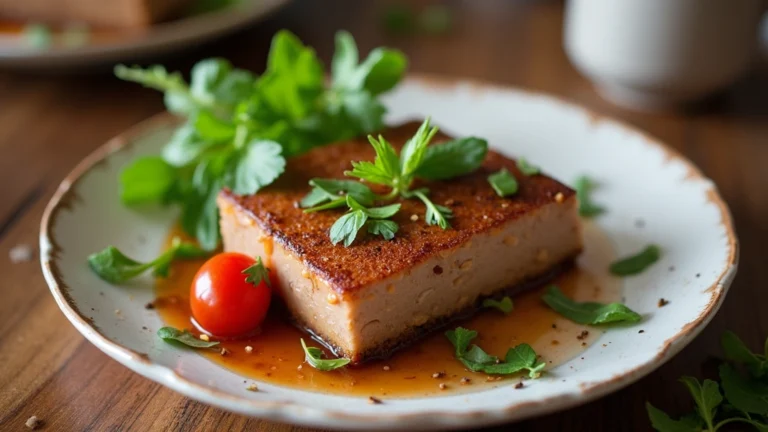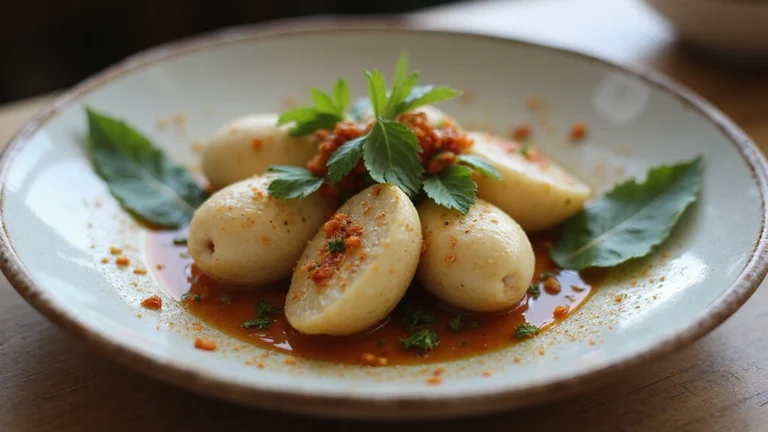
Ever wondered how to create restaurant-quality Furikake Ahi at home? This Japanese-Hawaiian fusion dish combines fresh, seared tuna with the umami-rich furikake seasoning for a meal that’s both impressive and surprisingly simple to prepare.
Furikake Ahi brings together the best of Pacific flavors in one stunning dish. The contrast between the rare, seared ahi tuna and the crunchy, savory furikake coating creates a texture and flavor experience that’s truly unforgettable. This dish has become a staple in Hawaiian cuisine, where fresh seafood meets Japanese culinary influence.
You’ll love how quickly this elegant meal comes together. Perfect for a special dinner that seems fancy but doesn’t keep you in the kitchen for hours. The vibrant colors and bold flavors will transport you straight to the shores of Hawaii with each delicious bite.
What Is Furikake Ahi Tuna?
Furikake Ahi Tuna represents the perfect marriage of Japanese seasoning and fresh Hawaiian seafood traditions. This exquisite dish features high-quality ahi tuna steaks quickly seared on the outside while maintaining a rare or medium-rare center. The star element is the furikake coating—a Japanese dry seasoning typically containing seaweed flakes toasted sesame seeds dried fish and various other umami-rich ingredients.
The preparation method preserves the tuna’s natural buttery texture while adding a complex flavor profile through the furikake crust. Many chefs enhance this dish with a drizzle of ponzu or soy-based sauce which complements the nutty sesame notes and oceanic undertones of the furikake.
Popular throughout Hawaii this dish exemplifies the islands’ cultural fusion cuisine that draws heavily from both Japanese culinary techniques and local ingredients. Restaurants across the islands offer variations with different accompaniments ranging from wasabi aioli to tropical fruit salsas.
What makes Furikake Ahi truly special is its balance of simplicity and sophistication. The minimal cooking preserves the tuna’s nutritional benefits including lean protein and omega-3 fatty acids while the furikake adds depth without overwhelming the fish’s natural flavor.
When properly prepared the exterior develops a satisfying slight crunch from the toasted furikake while the interior remains silky and tender. This textural contrast alongside the bold flavor combination explains why this dish has gained popularity well beyond Hawaiian shores appearing on upscale restaurant menus worldwide.
Why You’ll Love This Hawaiian-Inspired Dish
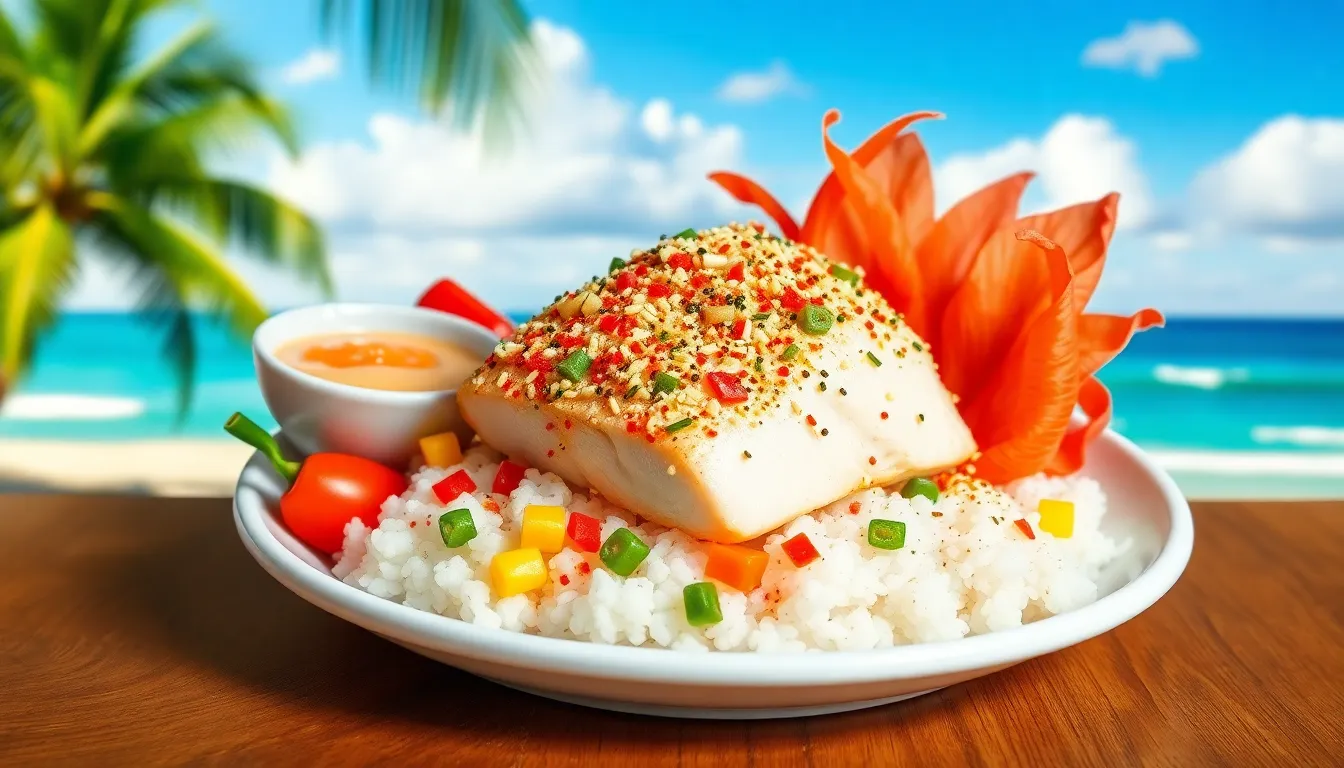
Flavor Explosion in Every Bite
Furikake Ahi delivers an extraordinary combination of textures and tastes that will tantalize your palate. The umami-rich furikake crust provides a savory nutty crunch that perfectly complements the buttery tender ahi tuna beneath. This textural contrast creates a memorable dining experience that feels both sophisticated and comforting. The Japanese seasoning blend introduces multiple flavor dimensions with its mixture of roasted sesame seeds seaweed and various seasonings.
Quick and Simple Preparation
You’ll appreciate how this impressive dish comes together in just 20-25 minutes total making it perfect for weeknight dinners when you want something special without spending hours in the kitchen. The preparation process is straightforward: marinate fresh ahi tuna briefly in a soy-based mixture press the furikake seasoning onto all sides then quickly sear in a hot pan. This minimal cooking technique preserves the tuna’s natural flavors while developing a delicious crust.
Nutritional Powerhouse
Ahi tuna offers exceptional nutritional benefits as a lean protein source rich in omega-3 fatty acids. When paired with furikake which adds flavor without important calories you get a dish that satisfies completely while supporting your health goals. The combination feels indulgent without the heaviness of many restaurant meals making it ideal for those seeking flavorful yet nutritious options.
Versatile Serving Possibilities
This Hawaiian-inspired dish adapts beautifully to various presentation styles. Serve your Furikake Ahi sliced over warm white rice with accompaniments like Kewpie mayo sriracha or a light soy vinaigrette. The vibrant colors create a stunning plate presentation worthy of any special occasion yet simple enough for everyday enjoyment. Many chefs enhance the dish with complementary sauces such as a warm soy vinaigrette or creamy garlic-ginger sauce to further elevate the flavor profile.
Perfect Cultural Fusion
Furikake Ahi exemplifies the beautiful marriage of Hawaiian and Japanese culinary traditions. This fusion represents the multicultural heritage of Hawaiian cuisine where fresh local ingredients meet international flavors and techniques. The dish honors the islands’ connection to both the bounty of the Pacific Ocean and the influence of Japanese immigrants who brought their culinary traditions to Hawaii generations ago.
Equipment Needed

To prepare restaurant-quality Furikake Ahi at home, gather these essential kitchen tools before starting:
- Non-stick or cast iron skillet – The heavy base provides even heat distribution for perfectly searing the tuna while maintaining a rare center
- Baking sheet lined with parchment paper – Optional but useful if you prefer finishing your ahi in the oven to set the furikake crust without overcooking
- Mixing bowls – You’ll need at least two: one for preparing the vinaigrette and another for the furikake coating
- Measuring spoons and cups – Essential for accurate ingredient proportions, especially when balancing flavors in the soy vinaigrette
- Sharp chef’s knife – A quality knife ensures clean cuts through the delicate tuna without tearing the flesh
- Grater or zester – For fresh ginger and garlic if including these aromatic ingredients in your vinaigrette
- Small whisk – Helps emulsify the vinaigrette ingredients for a smooth, well-blended sauce
- Tongs – Provides precise control when turning the ahi steaks in the hot pan
- Cutting board – Preferably with a groove to catch any juices when slicing the cooked tuna
- Instant-read thermometer – Optional but helpful for beginners to ensure the tuna reaches the ideal rare temperature (about 115°F in the center)
Having all equipment ready before beginning allows for efficient preparation of this quick-cooking dish where timing is crucial to achieve the perfect sear while maintaining the tuna’s tender interior.
Ingredients
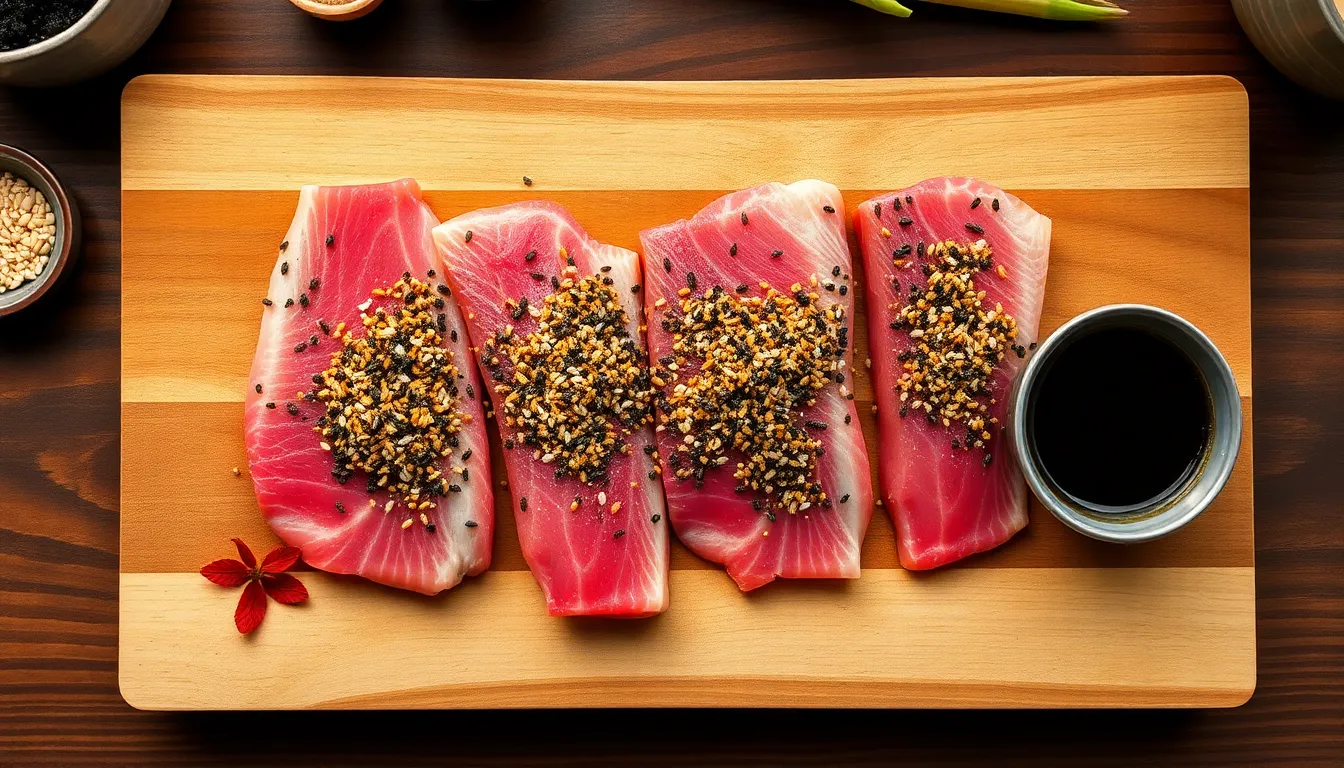
Creating restaurant-quality Furikake Ahi at home requires fresh ingredients divided into three key components. Each element plays an essential role in building the complex flavors of this Japanese-Hawaiian fusion dish.
For The Ahi Tuna
- 1 pound fresh ahi tuna steaks (sushi-grade)
- 3-4 tablespoons furikake seasoning
- 2 tablespoons high-heat cooking oil (avocado, vegetable, or macadamia nut oil)
- 1 teaspoon sesame oil (optional for added flavor)
- Soy sauce or tamari for rubbing (about 1 tablespoon)
For The Furikake Seasoning
- Store-bought furikake seasoning (look for varieties containing dried fish flakes, white and black sesame seeds, and seaweed)
- Alternatively make your own blend with:
- 2 tablespoons toasted white and black sesame seeds
- 2 tablespoons crumbled nori or seaweed flakes
- 1 tablespoon bonito flakes (dried fish)
- 1 teaspoon sea salt
For The Dipping Sauce
- ¼ cup soy sauce or tamari (gluten-free option)
- 1 tablespoon rice wine vinegar
- 2 teaspoons water
- 1-2 teaspoons honey or sugar
- 1 teaspoon toasted sesame oil
- 1 teaspoon roasted sesame seeds
- 1 teaspoon grated fresh ginger (optional)
- 1 small garlic clove minced (optional)
- ¼ teaspoon cayenne pepper or sriracha (optional for heat)
- 2 tablespoons thinly sliced green onions for garnish
How To Make Furikake Ahi Tuna

Transforming fresh ahi tuna into this Japanese-Hawaiian delicacy requires minimal cooking time but precise technique. Follow these expert steps to achieve restaurant-quality results with the perfect balance of crispy exterior and tender center.
Preparing The Ahi Tuna
Start with fresh sushi-grade ahi tuna steaks that are 1 to 1.5 inches thick, which ensures optimal texture and even cooking. Pat the tuna steaks completely dry with paper towels to create the perfect surface for the furikake to adhere. You have the option to enhance the flavor profile with a quick marinade before applying the furikake coating.
For an optional marinade:
- 3 tablespoons soy sauce
- 1 tablespoon rice wine vinegar
- 1 teaspoon honey
- 1 teaspoon freshly grated ginger
- 1 clove minced garlic
- 1 teaspoon sesame oil
Combine all marinade ingredients in a shallow dish and place tuna steaks in the mixture. Allow the tuna to marinate for 15-20 minutes to develop deeper umami flavors without compromising the fresh texture.
Making The Furikake Crust
Pour approximately 3-4 tablespoons of furikake seasoning onto a plate or shallow dish. Furikake typically contains a delicious blend of dried fish flakes, sesame seeds, seaweed pieces, and various spices that create a complex flavor profile.
Remove the tuna steaks from the marinade if used, allowing excess liquid to drip off. Press each side of the tuna firmly into the furikake mixture, ensuring an even coating on all surfaces. The seasoning should form a thin but complete layer that will create a flavorful crust when seared.
Searing The Tuna
Heat a cast iron or heavy skillet over high heat until very hot. Add 1-2 teaspoons of high smoke point oil such as vegetable or coconut oil and heat until just smoking, approximately 2 minutes. Place your furikake-coated tuna steaks carefully into the hot pan without overcrowding.
Sear each side for 30-90 seconds depending on the thickness of your steaks and your preferred level of doneness. For the ideal rare to medium-rare center that showcases the tuna’s buttery texture, aim for a quick sear that creates a crust while keeping the center cool. Transfer the seared tuna to a cutting board and let rest briefly.
Slice the tuna against the grain into thin pieces using a sharp knife to reveal the beautiful contrast between the seasoned exterior and rare center. Arrange the slices on warm white rice and garnish with sliced green onions, microgreens, or a drizzle of Kewpie mayo and sriracha for an authentic presentation.
Serving Suggestions
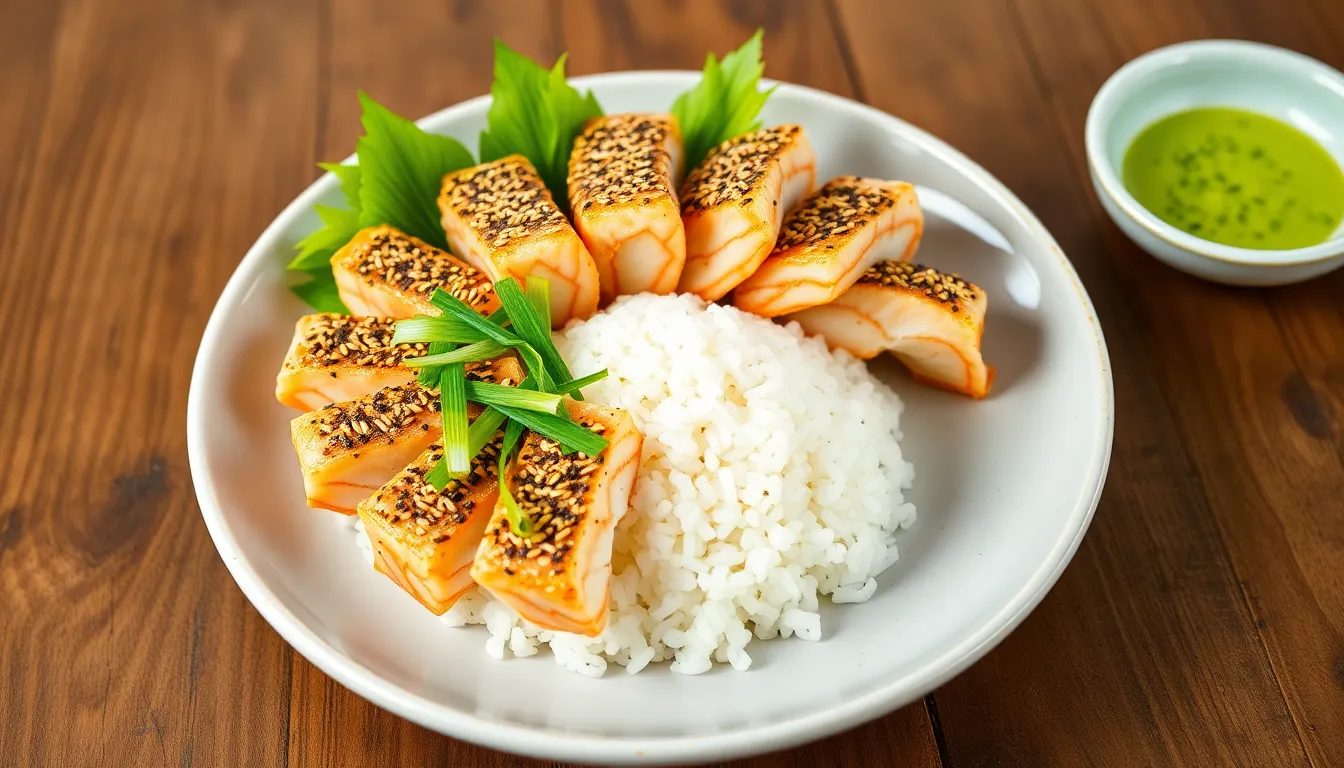
Transform your Furikake Ahi from a simple dish into an impressive meal with these restaurant-worthy presentation ideas. Traditionally served sliced thin over steaming white rice this dish allows the vibrant colors of the seared tuna to stand out against the neutral backdrop.
For a more substantial meal pair your Furikake Ahi with peanut noodles tossed in a light sesame sauce. The noodles provide a complementary texture and absorb the savory juices from the sliced tuna.
Balance the richness of the ahi with a refreshing side of spicy cucumber salad dressed with rice vinegar and a touch of sugar. Steamed Chinese greens like bok choy or gai lan also make excellent accompaniments adding nutritional value and a pleasant bitterness that cuts through the umami flavors.
Elevate your presentation with these signature sauces and garnishes:
- Drizzle Kewpie mayo mixed with sriracha over the sliced tuna for a creamy heat that enhances every bite
- Scatter thinly sliced green onions across the top for freshness and color
- Serve with a small dish of wasabi sauce on the side for those who enjoy an extra kick
- Pour warm soy vinaigrette made with rice vinegar soy sauce sugar water and sesame oil around the plate
For a dinner party presentation arrange the sliced Furikake Ahi in a fan pattern atop a small mound of rice with the sauce pooled artfully around the plate. Garnish with black and white sesame seeds for visual contrast and added texture.
Create a Hawaiian-inspired bowl by serving your Furikake Ahi alongside fresh avocado slices pickled ginger and a sprinkle of microgreens. This arrangement highlights the dish’s Pacific island heritage while providing a balanced mixture of flavors and textures.
For a lighter option wrap thin slices of the seared tuna in butter lettuce leaves with julienned vegetables and a small spoonful of rice creating elegant hand-held bites perfect for entertaining.
Storage And Make-Ahead Tips

Proper storage of both your furikake seasoning and ahi tuna is essential for maintaining quality and flavor. Follow these guidelines to ensure your ingredients remain fresh and your dish turns out perfectly every time.
Furikake Storage
Store homemade furikake in a cool dry place and use within 2 to 4 weeks as it lacks the preservatives found in commercial versions. Commercial furikake typically lasts 3 to 6 months after opening when kept in an airtight container away from moisture and direct sunlight. Consider refrigerating your furikake in humid environments to maintain its characteristic crunchiness and prevent it from becoming stale. Always use dry utensils when scooping furikake from its container to prevent moisture contamination that can lead to spoilage.
Ahi Tuna Storage
Fresh ahi tuna requires careful handling to maintain its premium quality. Keep it refrigerated at temperatures of 40°F (4°C) or below at all times. Wrap your tuna tightly in plastic wrap aluminum foil or place it in an airtight container to prevent cross-contamination and absorption of other food odors. For optimal flavor consume fresh ahi tuna within 1 to 2 days of purchase.
If you need to store your ahi tuna longer freeze it properly by wrapping tightly in plastic and placing in freezer bags to maintain quality for up to 3 months. Thaw frozen tuna in the refrigerator overnight before using it for your furikake ahi recipe to preserve its texture and taste.
Make-Ahead Considerations
Unlike many dishes furikake ahi is not ideal for make-ahead preparation as the seared tuna’s texture changes significantly when stored after cooking. The contrast between the crispy exterior and rare center that makes this dish special diminishes quickly.
You can prepare components separately in advance to streamline your cooking process:
- Mix your marinade ingredients up to 24 hours ahead and store in the refrigerator
- Measure and prepare your furikake coating in advance
- Slice garnishes and prepare sides earlier in the day
The actual searing of the tuna should be done immediately before serving to preserve the dish’s signature texture contrast and vibrant flavors. This last-minute cooking approach ensures your furikake ahi maintains the restaurant-quality experience that makes it so special.
Recipe Variations
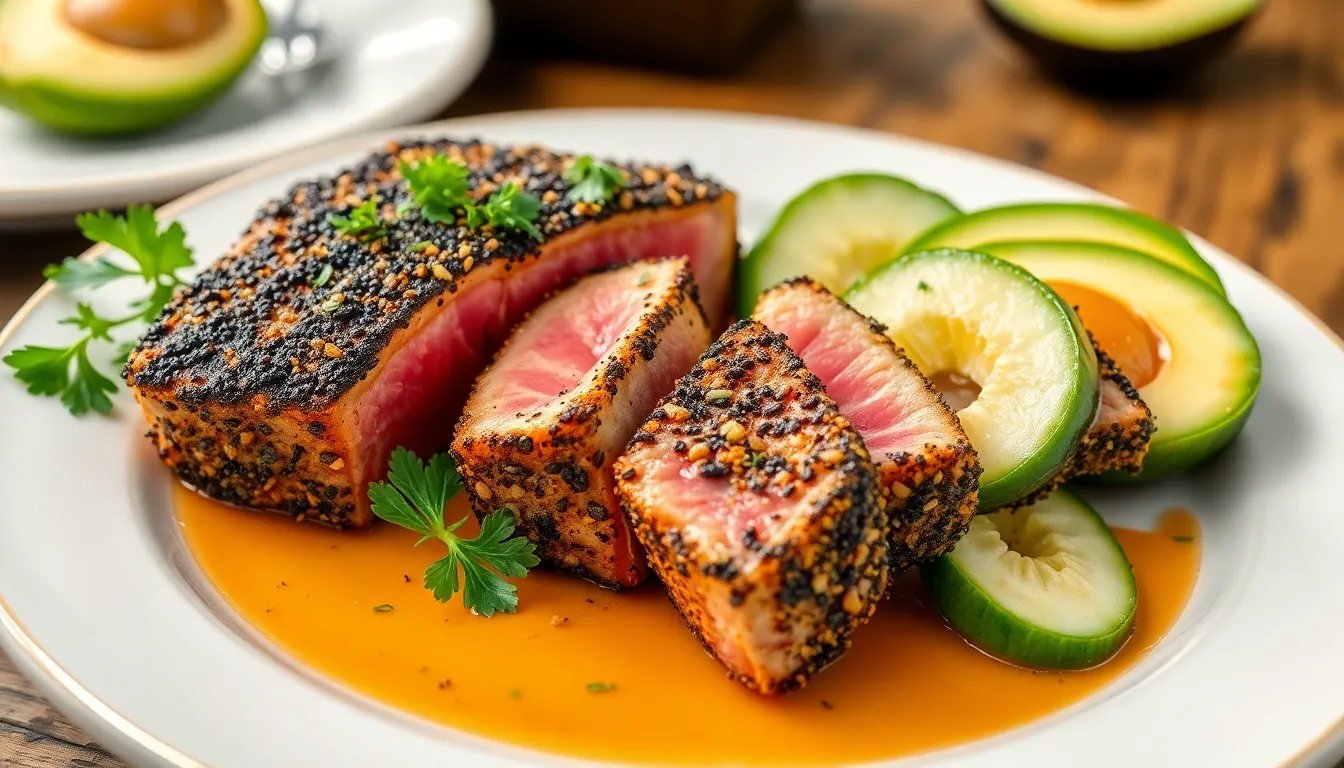
While the classic seared Furikake Ahi offers incredible flavor, you can explore these delicious variations to suit different preferences and cooking methods.
Baked Furikake Ahi
For a hands-off approach that still delivers exceptional taste, try baking your furikake-crusted ahi tuna. Begin by preheating your oven to 400°F and lightly oiling a baking sheet with parchment paper. Coat your ahi steaks with a thin layer of light oil before pressing the furikake mixture firmly onto all sides. Place the crusted tuna on your prepared baking sheet and bake for 8-10 minutes for medium-rare doneness. This method produces a milder crust texture compared to searing while allowing you to multitask with other meal components. The gentle heat of the oven helps preserve the tuna’s moisture while allowing the furikake flavors to infuse more deeply throughout the fish. Serve immediately after baking with your favorite sides for a delightful alternative to the traditional seared preparation.
Spicy Furikake Ahi
Transform your Furikake Ahi into a fiery delight with these spicy variations. Drizzle sriracha directly over your sliced tuna for an immediate heat kick that complements the umami-rich furikake coating. Create a creamy spicy sauce by mixing Kewpie mayonnaise with sriracha or gochujang paste, adjusting the ratio based on your heat preference. Add cayenne pepper to your dipping sauces for a warming spice that builds gradually with each bite. Experiment with wasabi or wasabi-infused furikake blends for a distinctive Japanese-style heat that clears the sinuses while improving the tuna’s natural flavor. Incorporate sliced jalapeños or shichimi togarashi (Japanese seven-spice blend) into your furikake mixture before crusting for heat distributed throughout each bite. These spicy adaptations maintain the dish’s elegant presentation while adding an exciting dimension of flavor that pairs perfectly with cooling sides like cucumber salad or avocado.
Health Benefits Of Ahi Tuna
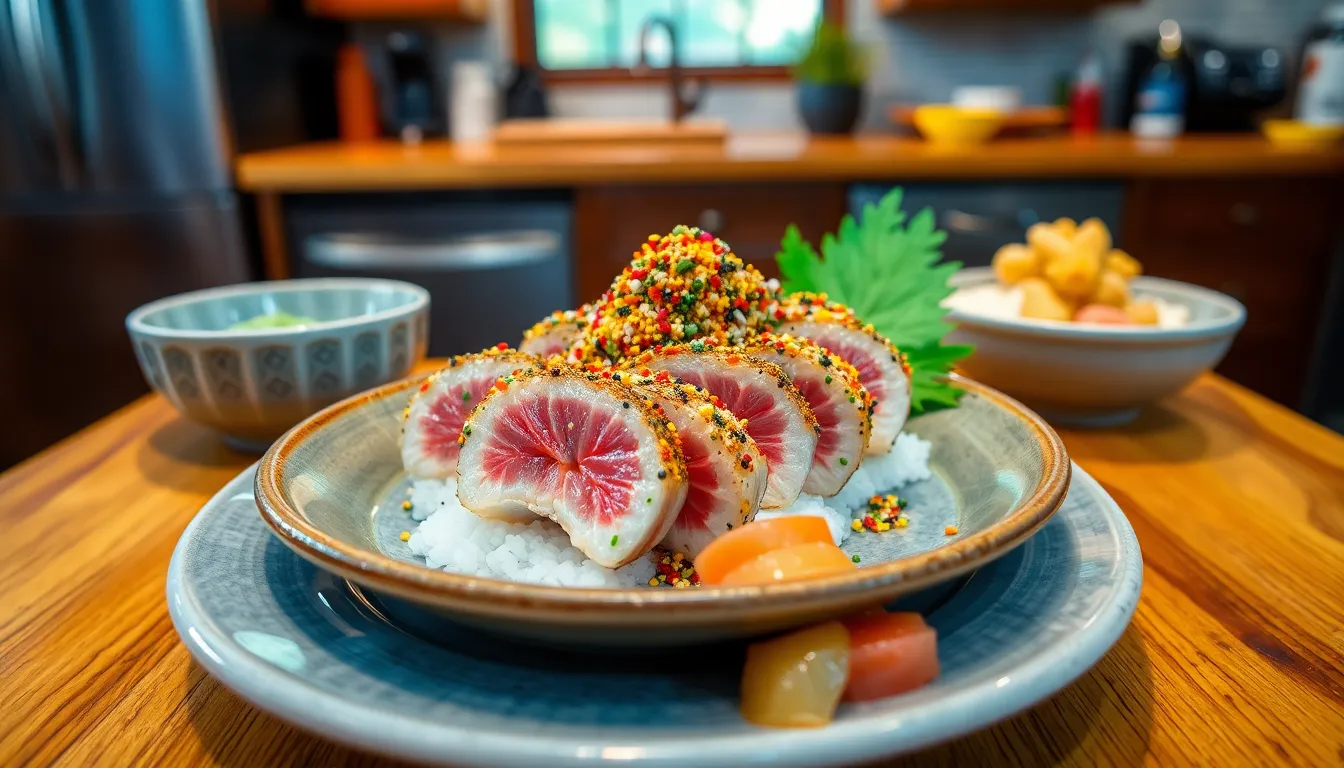
Ahi tuna offers remarkable nutritional benefits that make Furikake Ahi not just a delicious dish but also a wholesome choice for your diet. This premium fish delivers exceptional health advantages while maintaining its delectable taste profile.
Protein Powerhouse with Minimal Calories
Ahi tuna provides an impressive 25-38 grams of protein per serving while containing only 120-160 calories and approximately 1-1.5 grams of fat. This stellar nutritional profile makes it perfect for supporting muscle development and maintenance while assisting with weight management goals.
Omega-3 Fatty Acid Benefits
The abundant omega-3 fatty acids in ahi tuna deliver multiple health advantages for your body. These essential fats help reduce inflammation throughout your system while significantly improving heart health by lowering cardiovascular disease risk. Your brain function also receives substantial support from these omega-3s, improving memory and cognitive performance.
Essential Vitamins and Minerals
Ahi tuna serves as an excellent source of vital nutrients your body needs for optimal functioning:
- Vitamin B12 and B6: Support healthy blood cell formation
- Vitamin D: Promotes bone health and immune function
- Potassium: Regulates fluid balance and nerve signals
- Selenium: Benefits thyroid health and protects against autoimmune thyroid conditions
- Magnesium: Supports muscle and nerve function
- Phosphorus: Works with calcium for bone strength
- Iron: Enables proper oxygen transport throughout your body
Antioxidant Protection
The antioxidant properties in ahi tuna actively combat free radical damage in your body. Research suggests these protective compounds may contribute to lowering your risk of certain cancers, particularly prostate and breast varieties.
Mental Health Support
Regular consumption of omega-3 rich fish like ahi tuna correlates with reduced depression risk, with studies showing particularly notable benefits for women. The brain-supporting nutrients in this fish promote better overall mental wellbeing.
Bone and Muscle Enhancement
The vitamin D content in ahi tuna facilitates better absorption of calcium and phosphorus, which contributes to maintaining strong, healthy bones. Meanwhile, the high-quality protein supports effective muscle maintenance and growth, making this fish an excellent choice for active individuals.
| Nutrient Content Per 3-5oz Serving | Amount |
|---|---|
| Calories | 120-160 |
| Protein | 25-38g |
| Fat | 1-1.5g |
| Vitamin B12 | Important |
| Vitamin D | Important |
| Omega-3 Fatty Acids | Abundant |
| Selenium | Important |
By incorporating Furikake Ahi into your meal rotation, you gain access to this impressive array of nutrients while enjoying a truly delectable dining experience. The Japanese-inspired furikake seasoning enhances both the flavor and visual appeal without diminishing any of these substantial health benefits.
Where To Find Quality Ahi Tuna
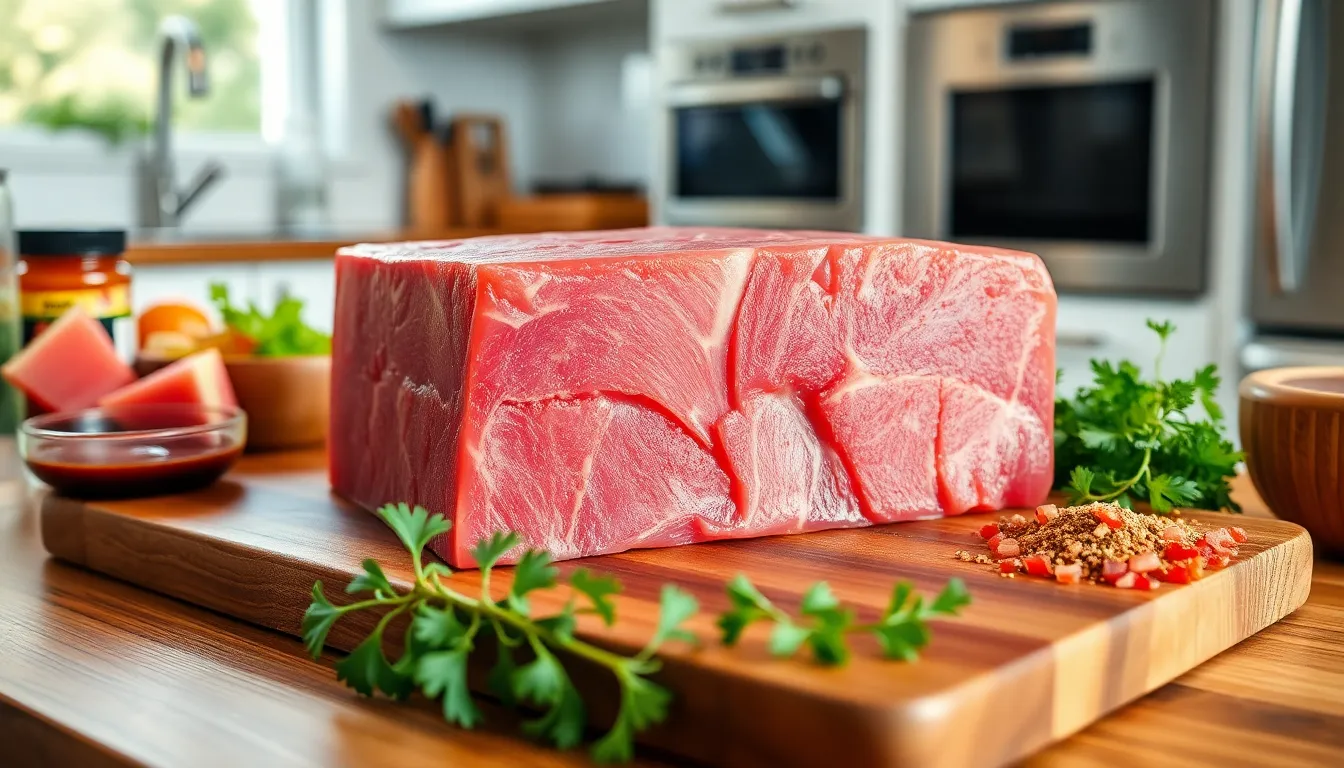
Finding high-quality ahi tuna is crucial for creating an authentic and delicious Furikake Ahi dish. The quality of your fish directly impacts both the taste and texture of your final preparation. To ensure the best results, you should seek out sushi or sashimi-grade tuna from reputable sources.
Reputable seafood markets and dedicated fishmongers offer your best option for finding fresh ahi tuna blocks or steaks. These specialists typically guarantee sushi-grade tuna that’s safe for consumption when served rare or raw. Ask your fishmonger about when the tuna was delivered and look for bright red flesh with firm texture and no fishy odor when making your selection.
Specialty Asian markets frequently carry fresh ahi suitable for Furikake Ahi preparations. These markets often have connections to quality seafood suppliers and may offer competitive prices compared to upscale seafood shops. Many also stock the furikake seasoning you’ll need, allowing you to complete your shopping in one location.
Well-stocked grocery stores with dedicated seafood departments sometimes offer sushi-grade ahi tuna. Whole Foods and similar premium grocers typically maintain higher standards for their seafood selections. Before purchasing, verify with the staff that the tuna is indeed sushi-grade and suitable for preparations that leave the center rare.
Online seafood suppliers have expanded access to premium ahi tuna for home cooks. Several reputable companies now ship fresh, sushi-grade fish directly to your door in specially insulated packaging. This option proves especially valuable if you live in an area without easy access to specialty seafood retailers.
When evaluating ahi tuna quality, remember these key indicators: the flesh should display a vibrant red color without brown spots or discoloration, the texture should feel firm with minimal liquid release when pressed gently, and there should be absolutely no fishy smell. Fresh ahi has a clean, oceanic scent that suggests proper handling and storage.
Your diligence in sourcing quality ahi tuna will significantly elevate your Furikake Ahi dish, allowing the pure flavors of this premium fish to shine through the savory furikake coating and complementary sauces.
Conclusion
Furikake Ahi stands as the perfect testament to Hawaiian-Japanese fusion cuisine with its extraordinary balance of flavors textures and visual appeal. By following the techniques outlined you’ll create a restaurant-worthy dish that’s both impressive and surprisingly simple to prepare.
This versatile dish offers endless possibilities for customization while delivering impressive nutritional benefits from heart-healthy omega-3s to lean protein. Whether you’re serving it over steaming rice with a drizzle of spicy mayo or presenting it as an elegant dinner party centerpiece Furikake Ahi never fails to impress.
The key to success lies in sourcing high-quality ahi tuna and mastering the quick sear that creates that perfect contrast between crispy exterior and buttery interior. It’s this careful balance that makes Furikake Ahi a true celebration of the Pacific’s culinary treasures.
Frequently Asked Questions
What is Furikake Ahi Tuna?
Furikake Ahi Tuna is a Japanese-Hawaiian fusion dish featuring fresh tuna steaks coated with furikake seasoning and quickly seared. The dish maintains a rare or medium-rare center while developing a flavorful crust. Furikake is a dry Japanese seasoning typically containing seaweed flakes, toasted sesame seeds, and dried fish, adding complex umami flavors to the buttery tuna.
How long does it take to prepare Furikake Ahi?
Furikake Ahi takes only 20-25 minutes to prepare from start to finish. This quick cooking time makes it perfect for weeknight dinners when you want something elegant without spending hours in the kitchen. Most of the time is spent on preparation, while the actual cooking process is very brief to maintain the tuna’s tender texture.
Is ahi tuna healthy?
Yes, ahi tuna is extremely healthy. It provides 25-38 grams of protein per serving with minimal calories and is rich in omega-3 fatty acids. Ahi tuna contains essential vitamins and minerals including B12, vitamin D, potassium, and selenium. These nutrients support heart health, cognitive function, and muscle development, making Furikake Ahi a nutritious and delicious meal option.
What equipment do I need to make Furikake Ahi?
You’ll need a non-stick or cast iron skillet for even searing, a sharp chef’s knife for clean cuts, mixing bowls for the seasoning and sauces, measuring tools, and tongs for turning the tuna. Optional equipment includes a baking sheet with parchment paper (for oven finishing), a grater for ginger and garlic, and an instant-read thermometer to check for doneness.
How do I know if my ahi tuna is fresh?
Fresh ahi tuna should have vibrant red flesh, a firm texture, and a clean oceanic scent without any fishy odor. Purchase sushi or sashimi-grade tuna from reputable seafood markets, dedicated fishmongers, or specialty Asian markets. The tuna should feel dense and resilient to the touch, never slimy or soft.
What can I serve with Furikake Ahi?
Traditional accompaniments include steaming white rice, peanut noodles, or spicy cucumber salad. For added flavor, drizzle with a mixture of Kewpie mayo and sriracha, garnish with sliced green onions, or add a warm soy vinaigrette. For lighter options, serve the tuna wrapped in lettuce leaves with fresh vegetables, or pair with a tropical fruit salsa.
Can I make Furikake Ahi ahead of time?
While you can prepare the furikake seasoning and sauce components ahead of time, the tuna itself should be seared just before serving. Homemade furikake keeps for 2-4 weeks in an airtight container. The tuna’s signature texture—crispy exterior and tender center—is best when freshly cooked and immediately served for the optimal dining experience.
What is furikake seasoning made of?
Furikake seasoning typically contains a mixture of dried seaweed (nori), toasted sesame seeds, dried fish flakes (bonito), salt, and sugar. Some variations include dried egg, wasabi, or dried vegetables. You can purchase pre-made furikake at Asian markets or online, or make your own customized blend by combining these ingredients in proportions that suit your taste preferences.
Is it safe to eat rare ahi tuna?
Yes, it’s safe to eat ahi tuna rare or medium-rare when using sushi-grade fish that has been properly handled and stored. This high-quality tuna is specifically processed to be consumed raw or partially cooked. The quick searing technique used in Furikake Ahi preserves the tuna’s tender texture while eliminating surface bacteria through high-heat cooking.
Can I use a different type of fish for this recipe?
Yes, while traditional Furikake Ahi uses yellowfin or bigeye tuna, you can substitute salmon, swordfish, or even mahi-mahi. Each fish will offer a different flavor profile and texture. When using alternative fish, adjust cooking times accordingly—firmer fish like swordfish require longer cooking, while salmon might need less time to prevent overcooking.
